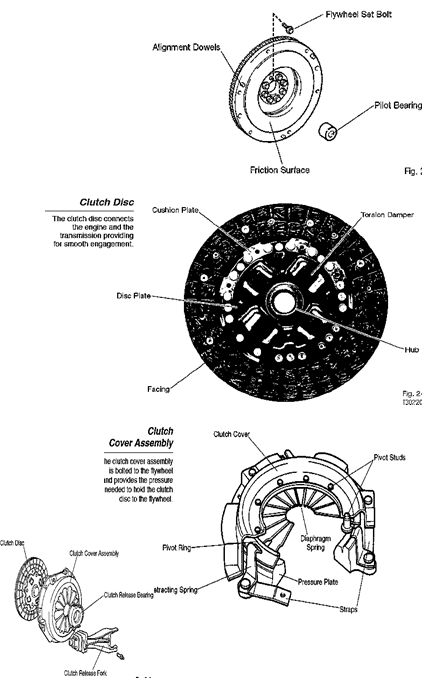←
Automobile Engineering
Main Parts Of Clutch
Introduction:
The clutch assembly interrupts the power flow between the engine and the transmission when the vehicle is brought to a stop with the engine running and when shifting gears.
Parts of clutch:
The clutch assembly consists of the following components:
• Clutch disc

• Flywheel
• Clutch cover assembly
• Clutch release bearing
• Clutch release fork
The clutch disc is connected to the input shaft of the transmission, and is located between the flywheel and clutch cover assembly. The flywheel is connected to the engine crankshaft and the clutch cover assembly is attached to the flywheel. The clutch release fork forces the clutch release bearing against the diaphragm spring of the clutch cover assembly.
- Flywheel:

- The flywheel is connected to the engines crankshaft. A flywheel is very similar to a brake rotor in appearance.
- It is a large metal disc that stores and releases energy pulses from the crankshaft. It drives the clutch by providing a friction surface for the clutch disc.
- In addition, the flywheel provides a mounting surface for the clutch cover, and also dissipates heat.
- Flywheel is very similar to a brake rotor in appearance. It is a large metal disc that stores and releases energy pulses from the crankshaft.
- Clutch Disc:
- The clutch disc is the connecting link between the engine and the transmission.
- A clutch disc provides a large surface area made of friction material on both sides. In the center, a damper assembly absorbs torsional vibration.
- The facing or friction material is riveted to the cushion plate on both sides and is similar to the composition of brake lining.
- The cushion plate has a wave design that allows the facings to compress when the pressure plate is engaged. This provides a smooth engagement of engine and transmission.
- Clutch Cover Assembly:
- The clutch cover assembly is bolted to the flywheel and provides the pressure needed to hold the clutch disc to the flywheel for proper power transmission.
- It is important that the assembly be well balanced and able to radiate the heat generated when the clutch disc is engaged.
- Clutch Release Bearing & Clutch Release Fork:
- The purpose of the clutch release bearing is to transfer the movement of the clutch release fork into the rotating diaphragm spring and clutch cover to disengage the clutch disc.